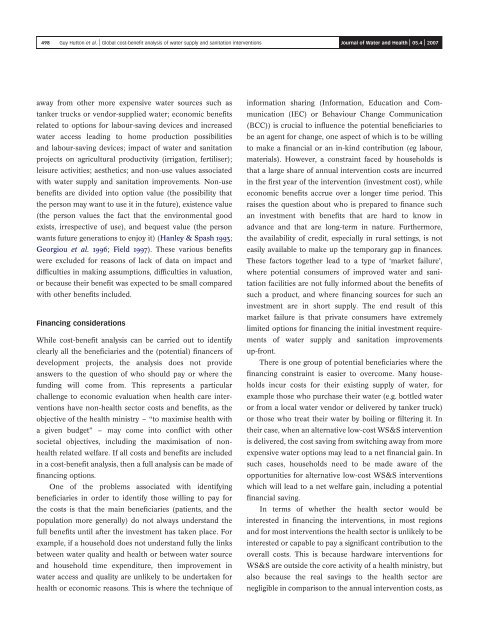Global cost-benefit analysis of water supply and sanitation ... - SuSanA
Global cost-benefit analysis of water supply and sanitation ... - SuSanA
Global cost-benefit analysis of water supply and sanitation ... - SuSanA
Create successful ePaper yourself
Turn your PDF publications into a flip-book with our unique Google optimized e-Paper software.
498 Guy Hutton et al. | <strong>Global</strong> <strong>cost</strong>-<strong>benefit</strong> <strong>analysis</strong> <strong>of</strong> <strong>water</strong> <strong>supply</strong> <strong>and</strong> <strong>sanitation</strong> interventions Journal <strong>of</strong> Water <strong>and</strong> Health | 05.4 | 2007<br />
away from other more expensive <strong>water</strong> sources such as<br />
tanker trucks or vendor-supplied <strong>water</strong>; economic <strong>benefit</strong>s<br />
related to options for labour-saving devices <strong>and</strong> increased<br />
<strong>water</strong> access leading to home production possibilities<br />
<strong>and</strong> labour-saving devices; impact <strong>of</strong> <strong>water</strong> <strong>and</strong> <strong>sanitation</strong><br />
projects on agricultural productivity (irrigation, fertiliser);<br />
leisure activities; aesthetics; <strong>and</strong> non-use values associated<br />
with <strong>water</strong> <strong>supply</strong> <strong>and</strong> <strong>sanitation</strong> improvements. Non-use<br />
<strong>benefit</strong>s are divided into option value (the possibility that<br />
the person may want to use it in the future), existence value<br />
(the person values the fact that the environmental good<br />
exists, irrespective <strong>of</strong> use), <strong>and</strong> bequest value (the person<br />
wants future generations to enjoy it) (Hanley & Spash 1993;<br />
Georgiou et al. 1996; Field 1997). These various <strong>benefit</strong>s<br />
were excluded for reasons <strong>of</strong> lack <strong>of</strong> data on impact <strong>and</strong><br />
difficulties in making assumptions, difficulties in valuation,<br />
or because their <strong>benefit</strong> was expected to be small compared<br />
with other <strong>benefit</strong>s included.<br />
Financing considerations<br />
While <strong>cost</strong>-<strong>benefit</strong> <strong>analysis</strong> can be carried out to identify<br />
clearly all the beneficiaries <strong>and</strong> the (potential) financers <strong>of</strong><br />
development projects, the <strong>analysis</strong> does not provide<br />
answers to the question <strong>of</strong> who should pay or where the<br />
funding will come from. This represents a particular<br />
challenge to economic evaluation when health care interventions<br />
have non-health sector <strong>cost</strong>s <strong>and</strong> <strong>benefit</strong>s, as the<br />
objective <strong>of</strong> the health ministry – “to maximise health with<br />
a given budget” – may come into conflict with other<br />
societal objectives, including the maximisation <strong>of</strong> nonhealth<br />
related welfare. If all <strong>cost</strong>s <strong>and</strong> <strong>benefit</strong>s are included<br />
in a <strong>cost</strong>-<strong>benefit</strong> <strong>analysis</strong>, then a full <strong>analysis</strong> can be made <strong>of</strong><br />
financing options.<br />
One <strong>of</strong> the problems associated with identifying<br />
beneficiaries in order to identify those willing to pay for<br />
the <strong>cost</strong>s is that the main beneficiaries (patients, <strong>and</strong> the<br />
population more generally) do not always underst<strong>and</strong> the<br />
full <strong>benefit</strong>s until after the investment has taken place. For<br />
example, if a household does not underst<strong>and</strong> fully the links<br />
between <strong>water</strong> quality <strong>and</strong> health or between <strong>water</strong> source<br />
<strong>and</strong> household time expenditure, then improvement in<br />
<strong>water</strong> access <strong>and</strong> quality are unlikely to be undertaken for<br />
health or economic reasons. This is where the technique <strong>of</strong><br />
information sharing (Information, Education <strong>and</strong> Communication<br />
(IEC) or Behaviour Change Communication<br />
(BCC)) is crucial to influence the potential beneficiaries to<br />
be an agent for change, one aspect <strong>of</strong> which is to be willing<br />
to make a financial or an in-kind contribution (eg labour,<br />
materials). However, a constraint faced by households is<br />
that a large share <strong>of</strong> annual intervention <strong>cost</strong>s are incurred<br />
in the first year <strong>of</strong> the intervention (investment <strong>cost</strong>), while<br />
economic <strong>benefit</strong>s accrue over a longer time period. This<br />
raises the question about who is prepared to finance such<br />
an investment with <strong>benefit</strong>s that are hard to know in<br />
advance <strong>and</strong> that are long-term in nature. Furthermore,<br />
the availability <strong>of</strong> credit, especially in rural settings, is not<br />
easily available to make up the temporary gap in finances.<br />
These factors together lead to a type <strong>of</strong> ‘market failure’,<br />
where potential consumers <strong>of</strong> improved <strong>water</strong> <strong>and</strong> <strong>sanitation</strong><br />
facilities are not fully informed about the <strong>benefit</strong>s <strong>of</strong><br />
such a product, <strong>and</strong> where financing sources for such an<br />
investment are in short <strong>supply</strong>. The end result <strong>of</strong> this<br />
market failure is that private consumers have extremely<br />
limited options for financing the initial investment requirements<br />
<strong>of</strong> <strong>water</strong> <strong>supply</strong> <strong>and</strong> <strong>sanitation</strong> improvements<br />
up-front.<br />
There is one group <strong>of</strong> potential beneficiaries where the<br />
financing constraint is easier to overcome. Many households<br />
incur <strong>cost</strong>s for their existing <strong>supply</strong> <strong>of</strong> <strong>water</strong>, for<br />
example those who purchase their <strong>water</strong> (e.g. bottled <strong>water</strong><br />
or from a local <strong>water</strong> vendor or delivered by tanker truck)<br />
or those who treat their <strong>water</strong> by boiling or filtering it. In<br />
their case, when an alternative low-<strong>cost</strong> WS&S intervention<br />
is delivered, the <strong>cost</strong> saving from switching away from more<br />
expensive <strong>water</strong> options may lead to a net financial gain. In<br />
such cases, households need to be made aware <strong>of</strong> the<br />
opportunities for alternative low-<strong>cost</strong> WS&S interventions<br />
which will lead to a net welfare gain, including a potential<br />
financial saving.<br />
In terms <strong>of</strong> whether the health sector would be<br />
interested in financing the interventions, in most regions<br />
<strong>and</strong> for most interventions the health sector is unlikely to be<br />
interested or capable to pay a significant contribution to the<br />
overall <strong>cost</strong>s. This is because hardware interventions for<br />
WS&S are outside the core activity <strong>of</strong> a health ministry, but<br />
also because the real savings to the health sector are<br />
negligible in comparison to the annual intervention <strong>cost</strong>s, as
















